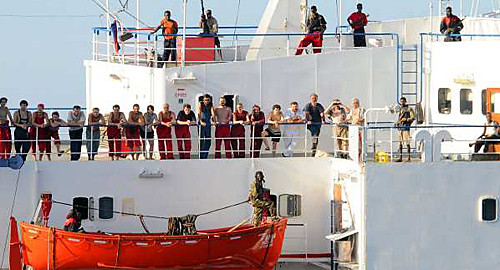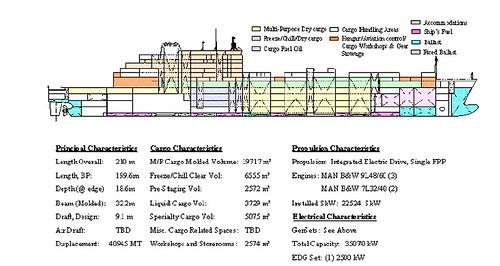Captives of Lewis and Clark

Up until now U.S. naval ships operating against pirates based in Somalia have been somewhat restricted. According to the Baltimore Sun, “U.S. warships could seize the pirates but had no authority to detain them or turn them over for criminal prosecution.” Yet, through a new agreement with the Kenyan government the U.S. Navy has gained the authority now to detain pirates long enough to transfer them to Kenya where they we be prosecuted and punished.
The Sun's article describes the Navy’s new mission in the Gulf of Aden, Task Force 151, set up just last month to help patrol roughly “a million square miles of water squeezed between the coast of Somalia and the Arabian Peninsula.”
Each year “26,000 merchant ships and oil tankers traverse this vital sea lane of global commerce. […] Last year the seizure of ships by Somali pirates leapt nearly 200 percent, reaching 111 reported attacks, according to the International Maritime Bureau's piracy reporting center in London.”

But, it’s not simply isolated there, as you know. “Last month, for example, there were 32 attempted attacks on ships around the world; of those, eight occurred in the Gulf of Aden.”
As part of a larger multinational effort, the U.S. 5th Fleet has sent additional ships into the gulf, that will be joined by the Coast Guard and other combat Marine search and seizure teams. While the UN uses UNOSAT to watch the seas from space, the Navy is using “an unmanned aerial spy plane known as the ScanEagle for target surveillance.” In what Navy Commander Stephen Murphy has described as “sort of racial profiling at sea,” the drone’s aerial footage is used “to help determine whether those on board the skiff are ethnic Somalis, and thus more likely to be pirates, or simply fishermen from elsewhere.”

[Image: USNS Lewis and Clark, via Global Security.]
Yet, what interests me most in all of this is one vessel in particular that will be joining this crew – the USNS Lewis and Clark, an old 689-foot, 24,000-ton Navy cargo ship, or T-AKE supply ship, that has been converted into a naval detention facility. According to Strategy Page, this ship has had its crew reduced from 158 to 118 so accommodations for 26 prisoners could be improvised.
The T-AKE we learn “is the grandchild of the Servron” which developed out of necessity during World War II, “because of a lack of sufficient forward bases in the vast Pacific.” The service squadrons (Servron) became a permanent fixture in the U.S. Navy backing up the other ships with feul, supplies and essential cargo.



[Image: USNS Lewis and Clark, via Global Security.]
Neverthess, not to our surprise, these Servrons also acted as prison ships during WWII. I haven't got much info but will soon enough on that chapter.
But for now, you can add the USNS Lewis and Clark to the list. In addition to concerns about mistakenly detaining innocent fisherman or innocents others, what could also be potentially very worrisome is whether this vessel will have any use or role in the roundup and rendition of ‘terrorist suspects’ in the good ol’ ‘War on Terror’ where too little transparency around unlawful detention and rendition exists.
If you read this article you will note, “Currently, six (T-AKE’s) are in service and eight are on order. The fourteen T-AKEs will replace 16 existing supply (separate ammo, cargo and fuel) ships that are reaching the end of their 35 year service life this year.” Not to read too much into things, but that could spell fourteen new prison ships soon circulating international waters. With the capacity for each to hold roughly 25 detainees, that would be 350 persons that could one day be swallowed up by the indefinite chambers of the nomadic fortress at sea.
Anyway, not to jump to any grim conclusions, all I'm sayin' is it's another ship to watch as the waves roll on.







2 Comments:
Thank you for this post. I was most interested in the information here, and also in your post on the nomadic fortress. One thing puzzled me though. Why did you use the picture of MEND from the Niger Delta, which is on the opposite side of the continent from Somalia? Is there some information on the use of the prison ships in N'Delta?
A friend sent me this link, and I find your work quite fascinating.
Honestly that was unintentional, and even that word (unintentional) is a bad excuse for not paying attention to that, partly in my failure of captions my deficits of knowledge and responsible interest are revealed.
Thanks for asking.
If I had to even try and justify not knowing about MEND in the image, I would say something to the piss poor effect that the piece speaks to the blurring of "pirates" and "terrorists" as targets in the eyes of the "War on Terror", whch floats prison ships with their own misidentity tragedies involved - will they be able to accurately distinguish guilty from innocent, pirate from fisherman, migrant from evil-doer?
Anyway, thanks for your comment. Appreciate you reading!
B
Post a Comment
<< Home